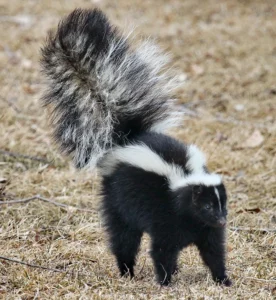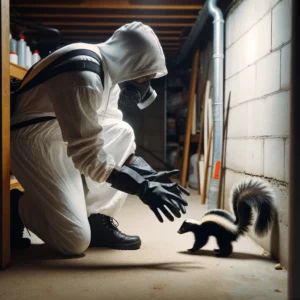
Skunks are fascinating creatures that are often misunderstood and feared by many. In this comprehensive guide, we will delve into the facts, characteristics, and wildlife threats associated with skunks in the Dallas-Fort Worth area. Understanding these animals is crucial for coexistence and effective management. Let's begin by exploring the biology and behavior of skunks.
Skunks, members of the Mephitidae family, are known for their distinctive black and white fur patterns. These medium-sized mammals have bushy tails, and some species have a small crest of fur on their heads. In the wild, skunks can live up to 3 years, while captive skunks have been recorded to live up to 10 years.
Skunks are nocturnal animals, meaning they are most active during the night. They have excellent hearing and sense of smell, which compensates for their relatively poor eyesight. When threatened or agitated, skunks emit a strong-smelling spray from their anal scent glands. This spray, composed of sulfur compounds, is highly effective at warding off predators.
Skunks are also known for their digging abilities. They have strong front claws that allow them to excavate burrows and search for food. Skunks are omnivorous, feeding on a variety of foods including insects, small mammals, fruits, and vegetables. They have a keen sense of smell that helps them locate their prey, even in the dark.
During the winter months, skunks may enter a state of torpor, similar to hibernation. They find a cozy den or burrow and reduce their metabolic rate to conserve energy. Skunks are solitary animals, except during the mating season. Males will compete for the attention of females, engaging in ritualized displays to establish dominance.
In North America, several species of skunks can be found, each with its own unique characteristics:

These species may have different habitat preferences and behaviors, but they all share certain traits that make them uniquely adapted to their environment.
Skunks play an important role in their ecosystems. As omnivores, they help control populations of insects and small mammals, which can have a significant impact on local ecosystems. Skunks also aid in seed dispersal by consuming fruits and then depositing the seeds in their droppings.
Despite their reputation for their strong odor, skunks are generally non-aggressive animals. They will usually give warning signs, such as stomping their feet or raising their tail, before resorting to spraying. Skunks prefer to avoid confrontation and will only use their scent glands as a last resort.
Skunks are fascinating creatures with unique adaptations and behaviors. Understanding these animals can help us appreciate their role in the natural world and coexist with them in harmony.
Skunks are fascinating creatures that inhabit various parts of North America. While they are generally docile and prefer to avoid confrontations with humans or other animals, it is essential to understand their behavior and potential threats they may pose.
Skunks are known for their distinctive black and white fur, which serves as a warning sign to potential predators. They have excellent hearing and sense of smell, allowing them to navigate their surroundings and locate food efficiently.
When it comes to encounters with humans, skunks usually try to keep their distance. However, like any wild animal, they can become aggressive if they feel threatened or cornered. It's important to respect their space and avoid provoking them in their natural habitat.
One of the most well-known aspects of skunk behavior is their ability to emit a powerful spray when they perceive danger. This spray, produced by specialized glands near their anus, contains a strong-smelling liquid called mercaptan. The odor is not only pungent but can also cause temporary blindness and intense discomfort, making skunks a threat to pets and humans who may accidentally startle or provoke them.
Skunks have a range of warning signals before spraying, including stomping their feet, hissing, and raising their tail. These behaviors serve as a clear indication to back away and give them space.

In addition to their defensive spray, skunks can also pose health risks to humans and other animals. They are carriers of various diseases, including rabies, distemper, and leptospirosis. While the transmission of these diseases to humans is relatively rare, it is crucial to exercise caution and avoid direct contact with skunks.
Skunk saliva or bites can transmit diseases, emphasizing the importance of seeking medical attention if you are bitten or scratched by a skunk. Additionally, if you come across a dead skunk, it is advisable to avoid touching it, as the carcass may still carry infectious agents.
Moreover, skunk dens can become infested with fleas and ticks, which can carry their own set of diseases. It's crucial to be cautious when near skunk habitats and take appropriate measures to prevent infestations and protect your health. This includes using insect repellents, wearing long sleeves and pants, and performing regular tick checks after spending time in areas where skunks are known to reside.
Skunks play an essential role in the ecosystem by controlling populations of insects and small rodents. While they may pose certain risks, it is possible to coexist with skunks by understanding their behavior, respecting their space, and taking necessary precautions to minimize potential conflicts.
Skunk infestations in residential areas are often caused by a combination of factors, including easy access to food sources and suitable habitats. These nocturnal foragers have a diverse diet that includes insects, small vertebrates, fruits, and vegetables. Human activities, such as leaving pet food outside or improperly secured trash containers, can attract skunks to residential areas.
Additionally, urbanization has resulted in the destruction of skunk habitats, forcing them to seek shelter in suburban neighborhoods. Understanding the reasons behind skunk infestations is crucial for implementing effective solutions.
Skunks are adaptable creatures and can thrive in various environments. However, certain factors make an area more attractive to skunks:
By addressing these environmental factors, we can reduce the likelihood of skunk presence in our immediate surroundings.
Skunks can be found in a variety of habitats, ranging from forests and grasslands to urban and suburban areas. They are adaptable and can thrive in human-altered landscapes as long as their basic needs are met.
Common skunk dwellings include abandoned burrows, hollow logs, brush piles, and under sheds or decks. These secluded areas provide the protection and security that skunks seek during the day when they are not actively foraging.
If you suspect skunks are present in your area, there are several signs to look out for:
Being aware of these signs can help you take proactive measures to address skunk-related issues.

If you find yourself with a skunk problem, it's important to approach their removal in a safe and humane manner. Here are some effective techniques:
It's essential to prioritize the safety of both humans and skunks when dealing with their removal.
Prevention is key when it comes to managing skunk-related problems. By implementing these tips, you can reduce the likelihood of skunks entering your property:
By taking these proactive measures, you can create a less attractive environment for skunks and minimize the risk of skunk intrusions on your property.
Skunks play a vital role in the ecosystem, and understanding their biology, behavior, and potential threats allows us to better coexist with these fascinating creatures. By practicing skunk-proofing techniques and addressing environmental factors that attract them, we can ensure a harmonious balance between humans and wildlife in the Dallas-Fort Worth area.